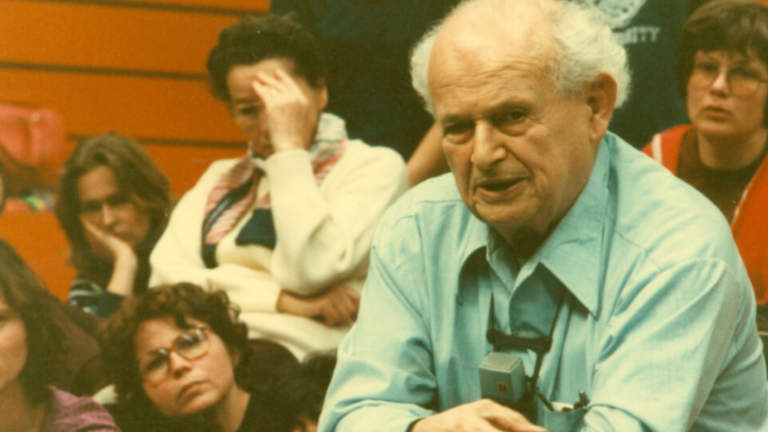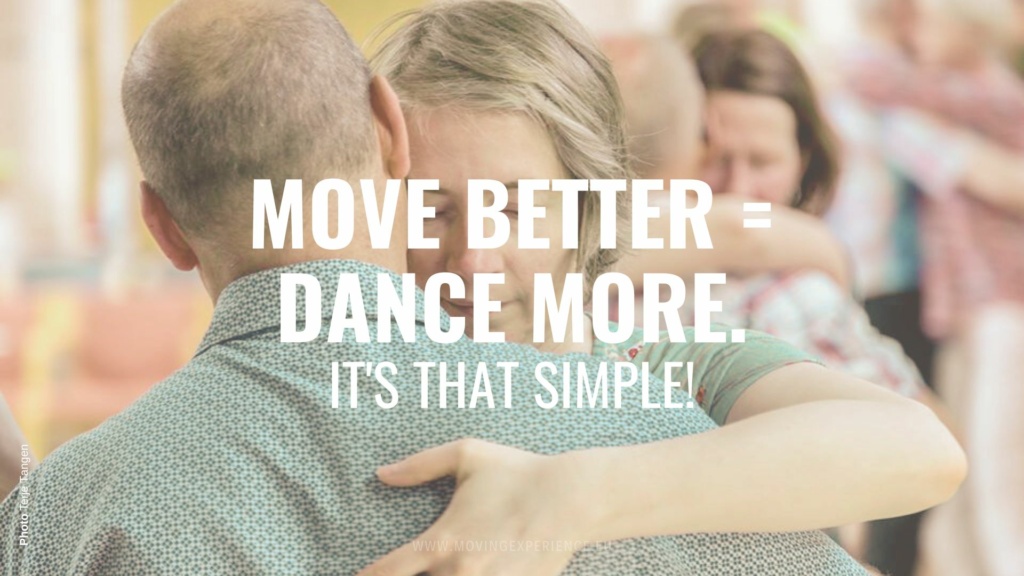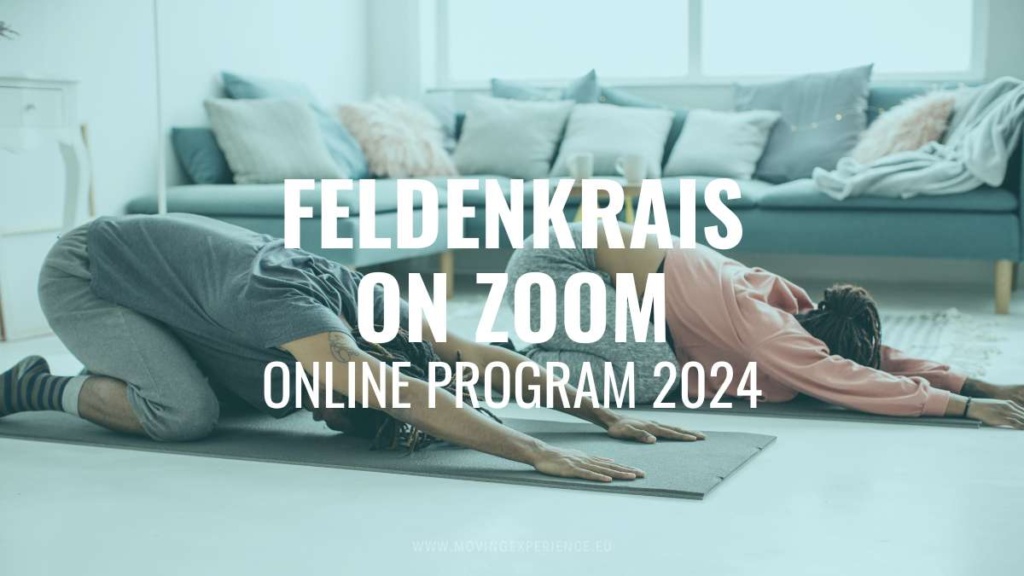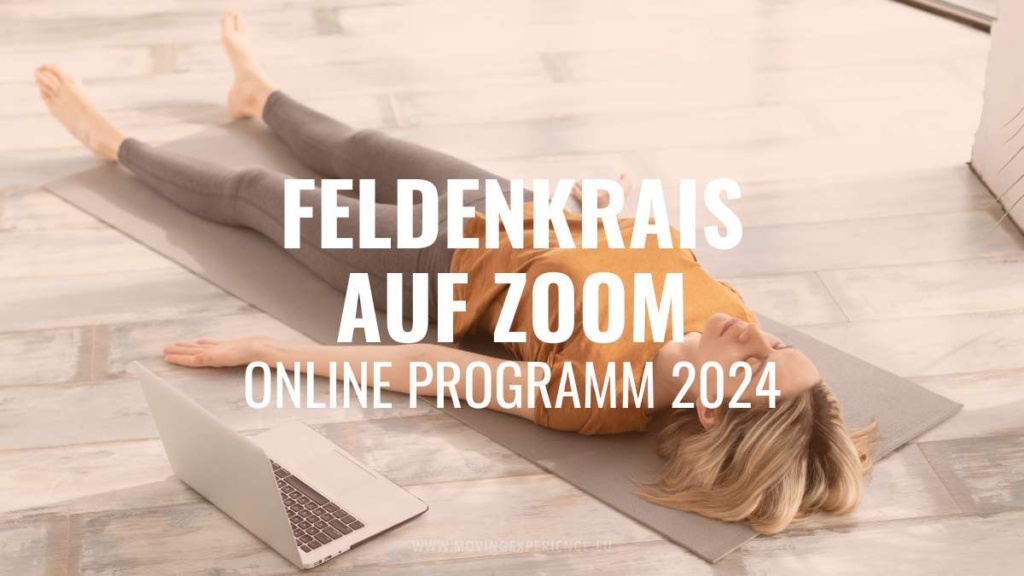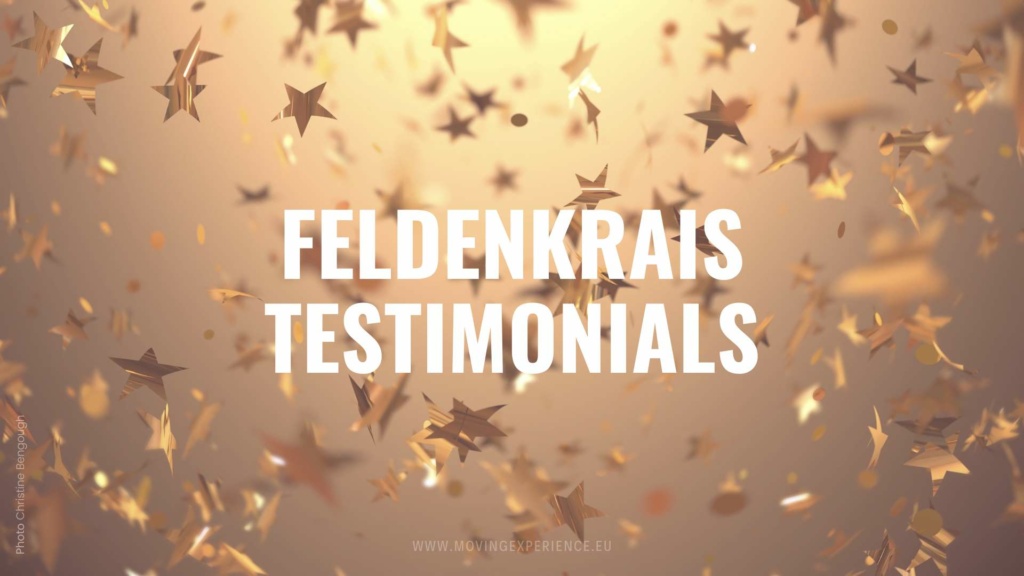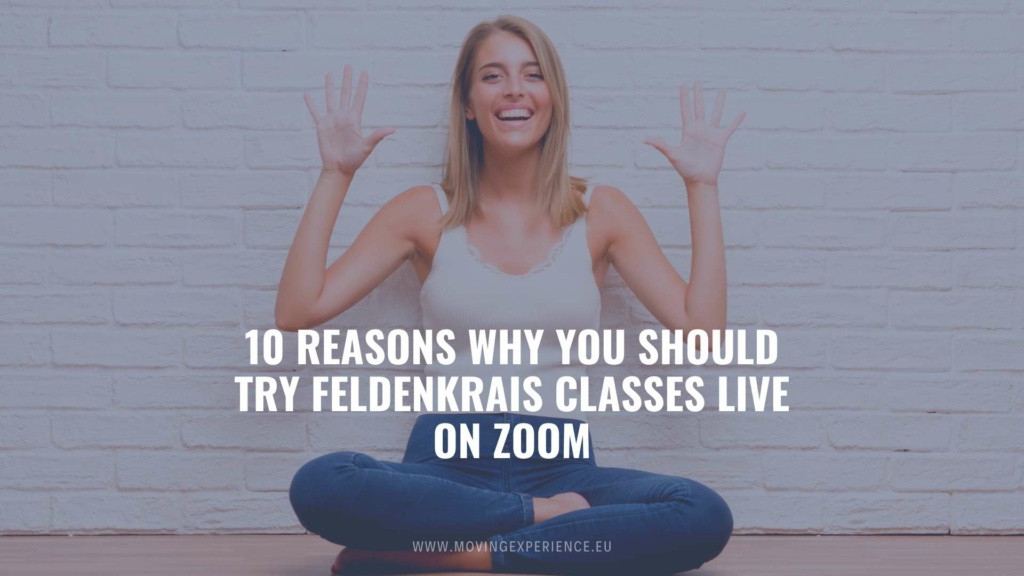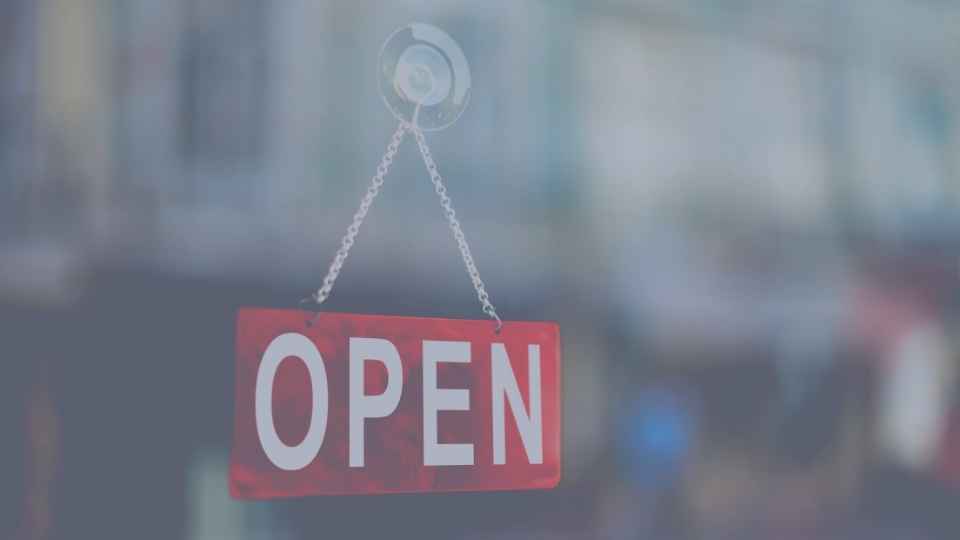Are you in love with The Feldenkrais Method? I am and I love the quotes by Moshe Feldenkrais too.
Moshé Feldenkrais has come up with a lot of brilliant material for thought and practice. With remarkable quotes. See the list below.
The Feldenkrais Method gains publicity and more and more practitioners worldwide offering Awareness Through Movement classes and Functional Integration lessons.
If you are a practitioner yourself and have a blog with quotes by Moshé Feldenkrais I am happy to link to it in exchange for a back link and a LIKE on Facebook (Moving Experience). Thank you in advance.
Explore more Information about The Feldenkrais Method »
Quotes by Moshé Feldenkrais
“Nothing is permanent about our behavior patterns except our belief that they are so.”
“In short, health is measured by the shock a person can take without his usual way of life being compromised”
“Movement is life. Life is a process. Improve the quality of the process and you improve the quality of life itself.”
“In order to change our mode of action, we must change the image of ourselves that we carry within us.”
“Make the impossible possible, the possible easy, the easy elegant.”
“You can’t teach anyone anything, you can only create the conditions in which they can learn.”
“People confound, misuse, interchange thinking and speaking, not realizing that speaking is for communication and thinking is for action.”
“Learning to inhibit unwanted contractions of muscles that function without, or in spite of, our will, is the main task in coordinated action.”
“Learning must be slow and varied in effort until the parasitic efforts are weeded out: then we have little difficulty in acting fast, and powerfully.”
“Standing is harder than moving.”
“It’s not a question of increasing your willpower. It’s a question of increasing your ability to do it.”
“The truly important learning is to be able to do the thing you already know in another way. The more ways you have to do the things you know, the freer is your choice. And the freer your choice, the more you’re a human being.”
“No matter how closely we look, it is difficult to find a mental act that can take place without the support of some physical function.”
“Find your true weakness and surrender to it. Therein lies the path to genius. Most people spend their lives using their strengths to overcome or cover up their weaknesses. Those few who use their strengths to incorporate their weaknesses, who don’t divide themselves, those people are very rare. In any generation there are a few and they lead their generation.”
“In order to recognize small changes in effort, the effort itself must first be reduced. More delicate and improved control of movement is possible only through the increase of sensitivity, through a greater ability to sense differences.”
“What I’m after isn’t flexible bodies, but flexible brains. What I’m after is to restore each person to their human dignity.”
“There are no teachers … there are only people learning and people learning how to facilitate learning.”
“I believe that the unity of mind and body is an objective reality. They are not just parts somehow related to each other, but an inseparable whole while functioning. A brain without a body could not think…”
“…self-knowledge through awareness is the goal of reeducation. As we become aware of what we are doing in fact, and not what we say or think we are doing, the way to improvement is wide open to us.”
“Willpower is necessary when the ability to do is lacking. Learning, as I see it, is not the training of willpower but the acquisition of the skill to inhibit parasitic action and the ability to direct clear motivations a result of self knowledge.”
“I believe that knowing oneself is the most important thing a human being can do for himself. How can one know oneself? By learning to act not as one should, but as one does.”
“To learn we need time, attention, and discrimination; to discriminate we must sense. This means that in order to learn we must sharpen our powers of sensing, and if we try to do most things by sheer force we shall achieve precisely the opposite of what we need.”
“Do it slowly, slowly, so slowly that it will be boring. When you begin to become bored you will find that it really is not so boring.”
“One has to set about learning to learn as is befitting for the most important business in human life, that is, with serenity but without solemnity, with patient objectivity and without compulsive seriousness . . . Learning must be undertaken and is really profitable when the whole frame is held in a state where smiling can turn into laughter without interference, naturally, spontaneously.”
“Health is the ability to realize our avowed and unavowed dreams.”
“The aim of the Feldenkrais Method is a person that is organized to move with minimum effort and maximum efficiency, not through muscular strength, but through increased consciousness of how movement works.”
“Without learning to know ourselves as intimately as we possibly can we limit our choices.”
“In other words, you can see where the training should be: not in the muscles, not in the lifting the weights, but the way we do it. And not in stretching… Not in jogging, but the way we jog… Not in swimming, but the way we swim. Not in skating, but the way we skate.”
“The aim is not complete relaxation, but healthy, powerful, easy and pleasurable exertion. The reduction of tension is necessary because efficient movement should be effortless. Inefficiency is sensed as effort and prevents doing more and better. The gradual reduction of useless effort is necessary in order to increase kinesthetic sensitivity, without which a person cannot become self-regulating.”
“The experienced Judoka, like the scientist, has learned to test ideas by their experimental value.”
“Purposeful action, which succeeds only when it is correctly performed, is far more important and beneficial than simple muscular effort.”
“Once you believe you have discovered the correct way to do something your learning is finished. You will not seek further improvement. Ignorance is the prerequisite to learning, and the more comfortable we are revealing our ignorance to ourselves, the more we will learn.”
“Many people have never made any but the most primitive use of their feet. As a result, the only use and idea associated with them is that of a plate-like support to the body.”
“An ability results from a structure being trained until a skilled functioning is obtained.”
“I start each case as if it were my first, and ask myself more questions than any of my assistants or critics ever do.”
“Life is not a stable process. Our ability to recover is our greatest quality.”
“Correcting the self-image is more useful than correcting a single action.”
“Efficient movement or performance of any sort is achieved by weeding out, and eliminating, parasitic, superfluous exertion. The superfluous is as bad as the insufficient, only it costs more.”
“A balanced distribution of tone is therefore found in the two groups of muscles in all postures. No part of the body can moved without another part being affected.”
“To every emotional state corresponds a personal conditioned pattern of muscular contraction without which the emotional state has no existence.”
“Learning is turning darkness, which is absence of light, into light. Learning is creation. It is making something out of nothing. Learning grows until it dawns on you.”
“When a person continues to use a stereotyped pattern of behaviour instead of one suitable to the present reality, the learning process has come to a standstill.”
“Every one of us has a large number of possible action patterns that have never been used before and that remain therefore entirely foreign. Certain combinations never occur, and a number of cells of the motor cortex may as a result remain dormant, constantly inhibited, or at least rarely active.”
“Stability is nice. It also means difficulty to initiate movement as well as difficulty to be moved. Stability increases the feeling of safety. Instability means risk, but easy mobility. Both are biologically important. Being addicted to one of them makes one unsafe for lack of choice.”
“My purpose is to allow people to move closer to actually being creatures of free choice, to genuinely reflect individual creativity and emotion, freeing the body of habitual tensions and wired patterns of behaviour so that it may respond without inhibition to do what the person wants.”
“Anything that is learned is learned slowly, without pushing. Anything you know well is like this. Everything you learned under duress, forcing, through pain, or with effort to succeed are things you forget. You never do them with pleasure and is worth nothing.”
“We must re-establish the function of attending to oneself, to one’s desires, to one’s needs, to the feelings of the body. Then we will find an integration of the fluency of movement through each joint into action where the integration itself is a new way of being.”
“The way I teach my students to work is to bring them in to conditions where they can learn to think. They have to learn to think without words, with images, patterns and connections. That sort of thinking always leads to a new way of action.”
“I do not intend to ‘teach’ you, but to enable you to learn at your own rate of understanding and doing.”
“We want to be ourselves, but act in a way so that our life is comfortable. We want to feel it is easy to do, then bring it to a state of elegance and aesthetic satisfaction.”
Interesting quotes taken from Moshé Feldenkrais’ books
“What we do now is the most important factor for tomorrow. Unless we change our emotional pattern of behaviour, tomorrow will resemble yesterday in most details except the date.”
from The Potent Self
”The essential human quality of forming, testing, and retesting new patterns of action and thought dares us to live by their conclusions and not by the standards of our parents, class, or social group.”
from The Potent Self
“Normally, one learns from experience, by correcting earlier patterns of behaviour. When a person continues to use a stereotyped pattern of behaviour instead of one suitable to the present reality, the learning process has come to a standstill. Some authors define neurosis as a series of stereotyped reactions to problems that the person has never solved in the past, and is still unable to solve in the present.”
from “Body and Mature Behaviour”
“Life is a process of time, and time cannot be fixed. Without learning to know ourselves as intimately as we possibly can, we limit our choice. Life is not very sweet without freedom of choice. Change is very difficult with no alternatives in sight; we then resign ourselves to not dealing with our difficulties as if they were prescribed by heaven.”
from “The Elusive Obvious“
“There is practically no limit to the quality of performance that awareness through movement will not transcend.”
from “The Elusive Obvious“
“Hours of repetitive practice is hard work; hours of practicing awareness in movement or action remain the most absorbing time in our lives.”
from “The Elusive Obvious“
“To me, there is nothing to correct. However, if you do something and you don’t know what you are doing, then it is incorrect for you. If you do know what you are doing, then whatever you do is correct for you.”
from “The Elusive Obvious“
“I believe that we actually limit ourselves by an undue and erroneous emphasis on what is important to the society of men at the neglect of how. How each individual can be helped to find his uniqueness and become unique in his contribution to himself and his social environment is too often neglected.”
“The Elusive Obvious”, Chapter 7, Awareness Through Movement
“The freedom to learn is a great liability. It is also a restriction from the start. There is no freedom of choice or free will where there is only one way of acting. Learning makes it possible to have alternative ways of performing anything. The ability to learn is synonymous with free choice and free will. But once learned, the choice is made, the dice is cast, and the tabula rasa is no more. Herein lies the liability as well as the restriction.”
from “The Case of Nora“
Awareness Through Movement lessons
The following quotes are from the Awareness Through Movement lessons by Moshé Feldenkrais. I stumbled upon them while preparing for my own ATM classes or when joining the An AY a Day lessons. You might find them as enlightening as I do.
This is not a question of good or bad. It is only important that it becomes easier to do each time.
AY#2 Seeing the heels, 9
Anyone, who intends to improve or thinks about improving himself, uses effort. Then movement does not go well and this disrupts the process of improvement more than anything else. If you move within your range of ability without trying to achieve a goal, you improve at the fastest rate possible. It is most important that it is comfortable to do.
AY#2 Seeing the heels, 12
Always having to breathe a certain way is not breathing; it is compulsion. A healthy body breathes differently in each situation.
AY#21 Contracting the abdomen while exhaling, 1
(..) There isn’t any difficulty in exhaling while your chest expands like a frog about to explode. You can let air flow out despite the expansion, but you need to lift your diaphragm to maintain the volume of your lungs. That is what you do.
AY#21 Contracting the abdomen while exhaling, 7
There is something very important to do at the end of a lesson. Many people think they are finished with the lesson when I say, “Stand up and observe any differences.” They think they need to run away. Seeing differences is one of the most important things.
AY#28 Legs crossed and expanding chest and abdomen, 10b
“(..) Most of you are moving too quickly. Do it so slowly that it will be a complete, clear waste of time. It is important to become used to the idea that here, in this class, you can waste the hour. There isn’t any need to rush. There isn’t anything to lose.”
AY#30 On the side; circles with the head and leg
“The floor as a teacher. The problem isn’t muscular, it is the “command mechanism” (the nervous system) which is why you do not improve through exercise alone. Only the floor can teach a person to hold his back softly so he can roll without any pain.”
AY#31 Lifting in Thought, on the Stomach
“You rest in the middle, not because the fatigue is so great, but in order to notice that something is changing in the body during and after the movement. You rest in order to learn practical, sensory anatomy — a culture far more important than exams.”
AY#63 Knee hiding the foot
“Pay attention to where you lose balance. You will see that it is at the same place where it becomes hard, or stiff in the head, and painful in the back.”
AY#65: “Weighing” the head in the circumference; sitting cross-legged and standing on the knees
“The point is that there is nothing, nothing that we do not learn … – even the simplest movements.”
AY#85 Bending the right ear to the right shoulder and the left ear to the left shoulder
“You should stop the moment you feel an interruption. How can you learn anything if you continue the movement after the interruption? You should stop the moment you lose balance and see what you did that wasn’t in order. Otherwise you can do this a million times, and it will still be disordered.
AY#90 Lengthening the arms; sitting cross legged, 11a
Whoever thinks they can succeed by decision deceives themselves. The person, in order to learn something new, needs to know what he is doing.”
“Pay attention to what interferes with doing the movement with true comfort, so it will be pleasant to do. You will see that it is only necessary to stop interfering with yourself [so that] all which is intended to be done, is done without internal resistance. This means to listen whether [you] use one muscle to interfere with another.”
AY#102 Oscillations with lifting the head towards sitting, 3b
“Do this movement slowly, without force, because it is impossible to change the world in an instant… to create is not possible in an instant.”
AY#190 Heels under the pelvis #1 [In and out]
See how seconds of work like this does something to the body that no exercise is able to do.
AY303 Self Image, the line of a ball that rolls, 7
“(..) It is not important that it will be high. It is not important that it should be good. It is not important that it be pretty. It is just necessary that it be at the same moment, in one movement, so the movement will be coordinated.”
AY314 Preparation for a candle, 3a
” (..) Reduce and reduce the movement until there will be no movement, but only the thought of the movement; so it will be possible to see the skeleton in movement without doing it. In other words, it will be possible to distinguish the organization and the thought that fills the body image during this movement. (..)”
AY335 Pushing the hip backward, 2
“(..) Now, pay attention if there is any difference. Whoever paid attention to the difference between the legs will find that he suddenly goes down lower. All of a sudden, he feels that this leg disturbs, that this thigh disturbs. Only when he knows what to correct does he have some chance that it will be corrected. But, if he simply knows that he does not know “to do” — he never fixes himself. (..)”
AY#356 Bending Knees with Toes Lifted, 8c
“(..) Distinguish between learning and doing. When you learn how to do something, you must do less than you are able to do. When you “do” you must be able to do it quickly, powerfully with everything good. When you learn, it is not the same thing. It is not “to do.” Whoever does not distinguish between these two things, never learns.”
AY#399 Differentiation in turning — arm, head, and leg, 7
“Do gradual movements. It will come by itself. To the degree that you do many easy movements, it will improve and go much better than if you effort. It will go to the side without pain. Also, if you effort, it will hurt afterward.”
AY #427 On the side, lifting the heels, 4a
“(..) If you know what you are doing, you can do what you want. If you do not know what you are doing, you cannot do what you want. (..)”
AY#536 Fingers interlaced on the chest, 3d
“(..) Do one good movement and not twenty bad ones because if you do one good one, it is possible to do another one better. If you do twenty bad ones the twenty-first will also be bad, also the hundredth, and also the thousandth. Whoever does not have patience cannot learn. He can just do and be killed. (..)”
AY#539 Fresh Standing, 7d
“Slowly, stop anytime you feel strain. It’s not a question of increasing your willpower. It’s a question of increasing your ability to do it.”
Esalen1972 Workshop Audio Lesson 11 Shoulder Rotation (Wringing)
The San Francisco Training (1975-1977)
The following quotes are from the San Francisco Training Moshé Feldenkrais was conduction from 1975 to 1977. I am currently working my way through them and teaching the material in my online Feldenkrais classes. You might find them as enlightening as I do.
First you will find that you can do it better by doing something that helps you to do it. Once you have learned, experienced that, you don’t need that help anymore.
June 17, 1975 – Day 2, week 1: Tuesday morning
It’s the only way to learn: to experience, try out, see for yourself and not take anything on trust.
June 17, 1975 – Day 2, week 1: Tuesday morning
You do it gently, you will get there easier.
June 17, 1975 – Day 2, week 1: Tuesday morning
You can see, I can tell it from you, that you feel it’s right. And some keep on doing the same thing and believe that they will get better by repeating the same thing a million times. Huh. (…) Fetish believing in repetition. I say a silly thing a million times, it still remains a silly thing. It’s not by repeating that you improve.
June 17, 1975 – Day 2, week 1: Tuesday afternoon
Now can you see that it is essential, in order to become intelligent, you have to know what you are doing and be able to distinguish one from what you are doing. And then you can differentiate and be able to do what you want. And that is with grace and ease. And this is learning and not exercising.
June 19, 1975 – Day 4, week 1: Thursday afternoon
Unless you know what you’re doing, you can’t change what you want to do.
June 19, 1975 – Day 4, week 1: Thursday afternoon
(..) if she does the same thing two hours running, without inter[fering], without stopping, then the parts that work overtime which are not necessary will get tired, and she will have to drop them. And therefore, that’s one of the important parts of yoga, and that’s why so many people do it.
June 19, 1975 – Day 4, week 1: Thursday afternoon
Because you have an asana [yoga pose] and you have to stay in the asana. If you stay long enough, even an idiot becomes aware of it, if you stay two hours in the same position. Now that is the advantage. Take that away and there is no advantage at all. (chuckles) It’s an advantage that it enables everybody who works, to stay in that position for a long time, you will become aware of what’s wrong.
Nobody can change unless he realizes the futility of his work. (..) I only give her the opportunity to find that she can do it also in another way, and if she prefers the first, she can do it.
June 19, 1975 – Day 4, week 1: Thursday afternoon
(..) in this lies the importance of that way of teaching. Because you can see, it’s not enforcing neither my opinion, nor my will, nor my preference on anybody. It’s only giving you the freedom of choice and giving you the freedom of distinction—the ability to distinguish, to differentiate and do the way you wish. That’s your business. Therefore, to my mind, this is the only way of teaching. It doesn’t matter what you teach, but the attitude for teaching should be like that. Otherwise it’s not teaching—it’s brainwashing.
June 19, 1975 – Day 4, week 1: Thursday afternoon
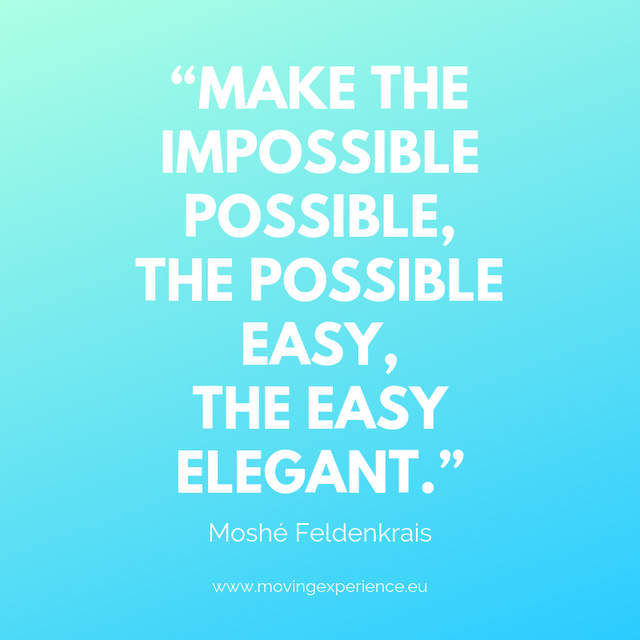
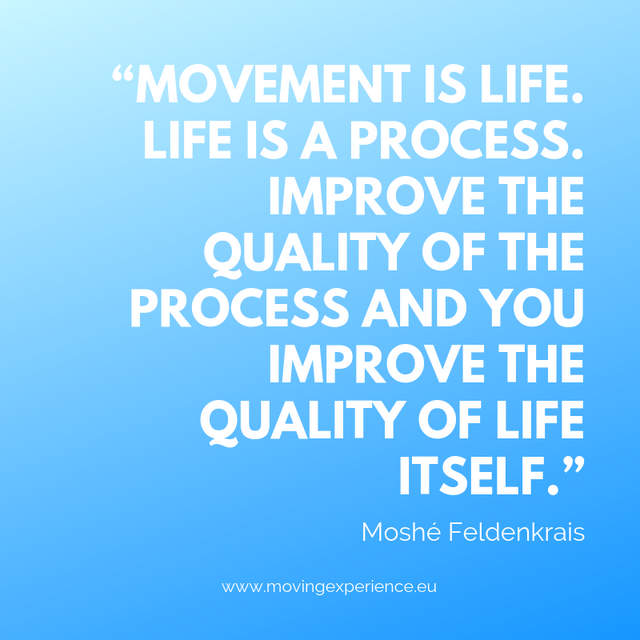
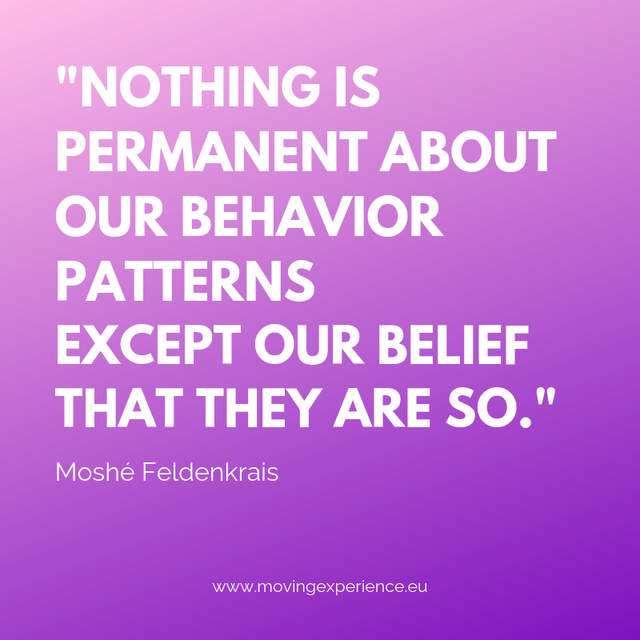
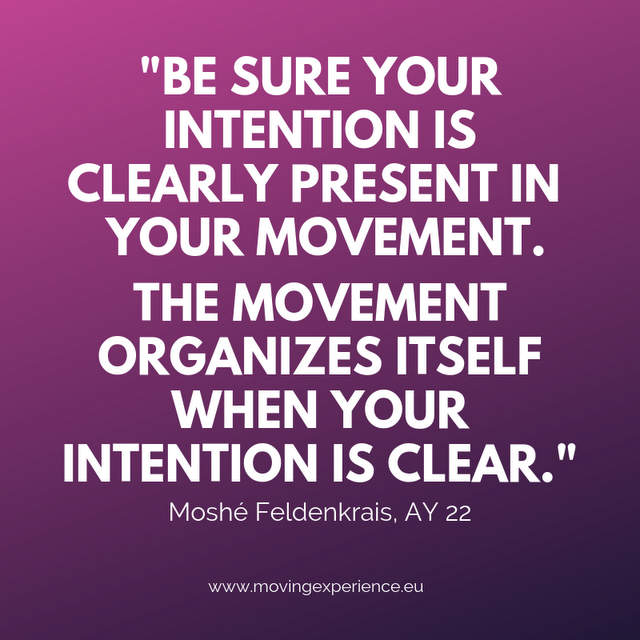
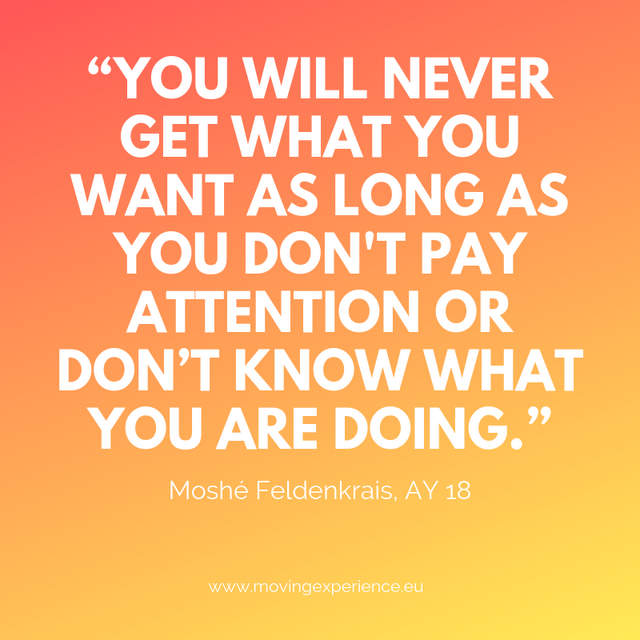
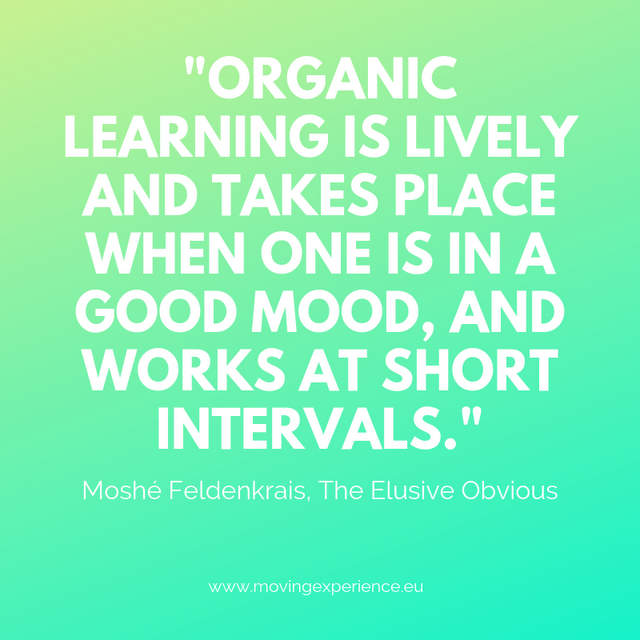
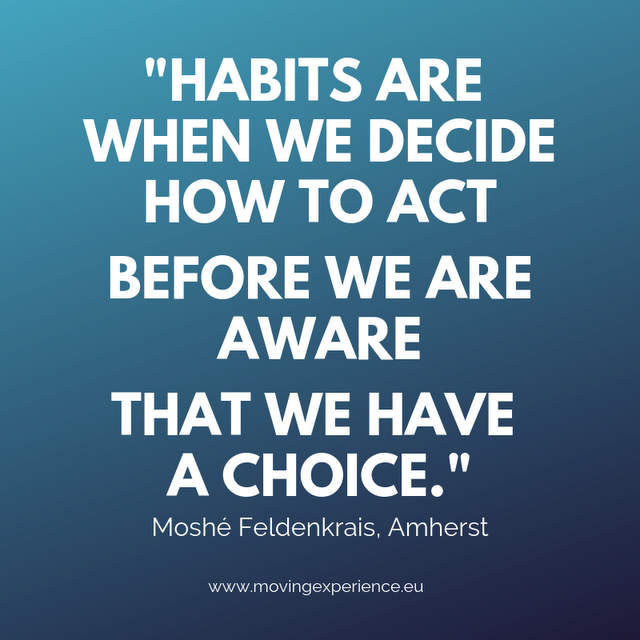
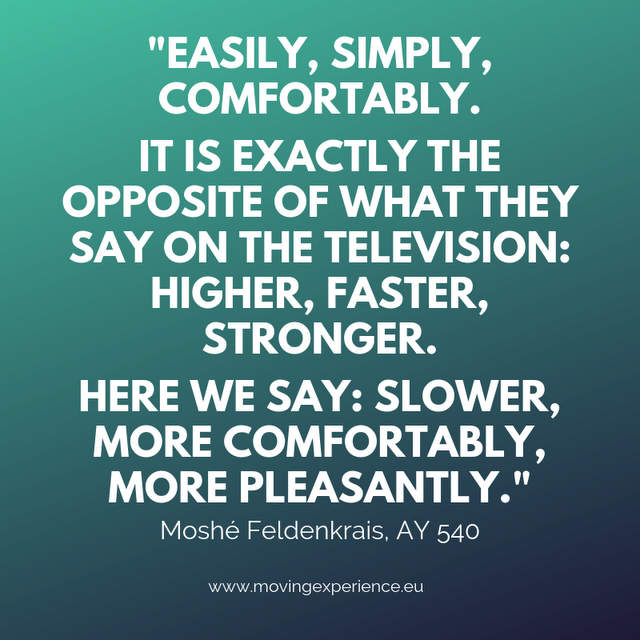
Please feel free to share those visuals if you like them. You’ll find bigger versions of them on my FB page Moving Experience and on my Instagram account.
… Room For More …
Your Favourite Quote Is Missing?
Is your favourite quote by Moshè Feldenkrais missing? Or have you created your own blog post with quotes by him and would like me to add it to this list?
Drop me (Bärbel Rücker) a line via email: info (at) movingexperience (dot) eu.
